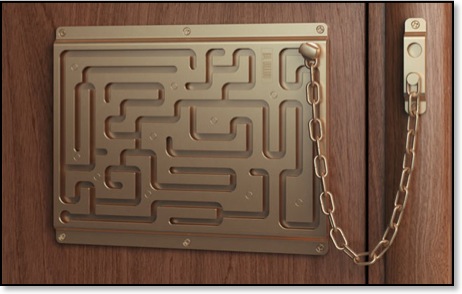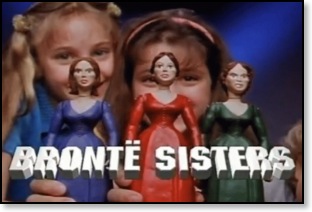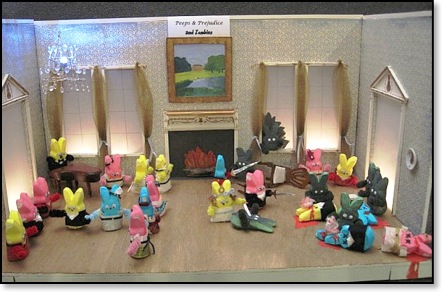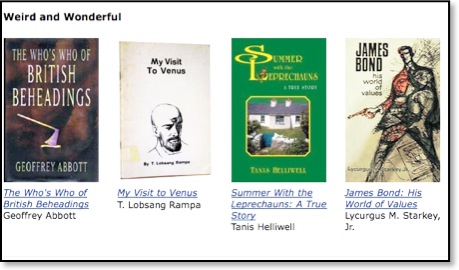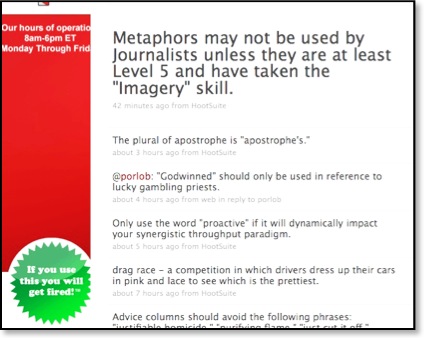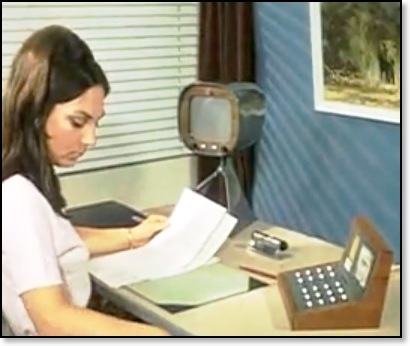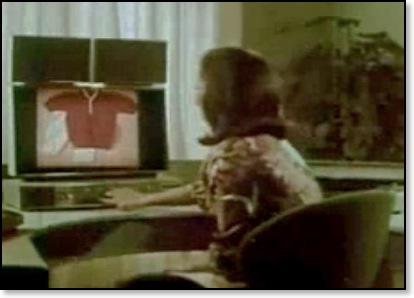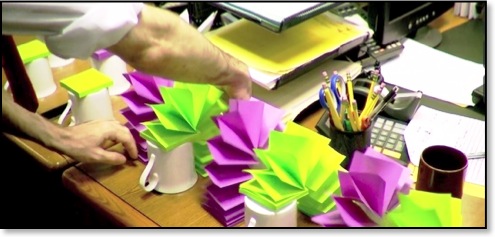silliness
Most misspelled words on Google
06/07/10 10:56
The
examples of misspellings that Google sees most often
are typos of very frequently searched terms, such as
“Criagslist” instead of “Craigslist” and “Facebok”
instead of “Facebook.” But Mr. Paskin
said words
that aren’t spelled the way they sound also give
people trouble.
He cited a few of the most common examples:
* “definitely,” which is often spelled “definately,” “definetly” or “definatly”* “stilettos,” which people spell “stilletos,” and “stillettos”* “mischievous,” spelled “mischevious” and “mischievious” and* “nauseous,” which comes out “nautious,” “nauseas” and “nausious.”
Stilettos? Really, is that a most used term?
More here at the WSJ
He cited a few of the most common examples:
* “definitely,” which is often spelled “definately,” “definetly” or “definatly”* “stilettos,” which people spell “stilletos,” and “stillettos”* “mischievous,” spelled “mischevious” and “mischievious” and* “nauseous,” which comes out “nautious,” “nauseas” and “nausious.”
Stilettos? Really, is that a most used term?
More here at the WSJ
Librarians do Lady Gaga
06/02/10 10:51
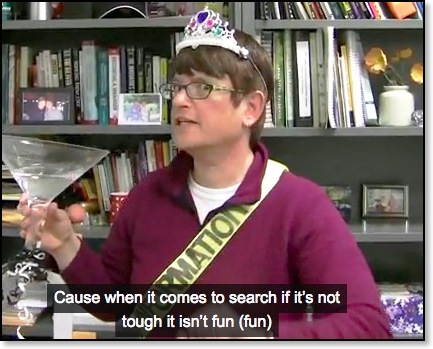
See the whole thing here
It's the UW Library School, with many featured cameos - Nancy Pearl, Bob Boiko, etc.
Geekware
05/27/10 10:45
Annual Peep Contest!
04/02/10 08:10
April Fools!
04/01/10 08:07
Best
April Fools list selection from the
Museum of Hoaxes:
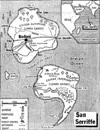
#5: San Serriffe 1977: The British newspaper The Guardian published a special seven-page supplement devoted to San Serriffe, a small republic said to consist of several semi-colon-shaped islands located in the Indian Ocean. A series of articles affectionately described the geography and culture of this obscure nation. Its two main islands were named Upper Caisse and Lower Caisse. Its capital was Bodoni, and its leader was General Pica. The Guardian's phones rang all day as readers sought more information about the idyllic holiday spot. Only a few noticed that everything about the island was named after printer's terminology. The success of this hoax is widely credited with launching the enthusiasm for April Foolery that gripped the British tabloids in subsequent decades.

#5: San Serriffe 1977: The British newspaper The Guardian published a special seven-page supplement devoted to San Serriffe, a small republic said to consist of several semi-colon-shaped islands located in the Indian Ocean. A series of articles affectionately described the geography and culture of this obscure nation. Its two main islands were named Upper Caisse and Lower Caisse. Its capital was Bodoni, and its leader was General Pica. The Guardian's phones rang all day as readers sought more information about the idyllic holiday spot. Only a few noticed that everything about the island was named after printer's terminology. The success of this hoax is widely credited with launching the enthusiasm for April Foolery that gripped the British tabloids in subsequent decades.
This is funny
08/16/09 10:43
Who needs a
logo designer for your business cards or web site,
when you can get this:
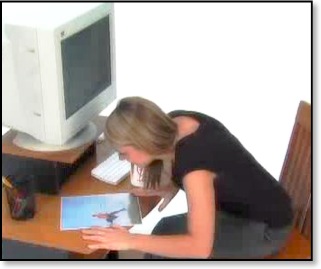
"Make My Logo Bigger cream," and more

"Make My Logo Bigger cream," and more
I'm hot, so let's bake cookies in the car!
07/20/09 11:27
Baking Bites has been
experimenting with cooking cookies in a hot car!

Car-Baked Chocolate Chip Cookies
1 1/2 cups all purpose flour
1/2 tsp baking powder
1/2 tsp baking soda
1/2 tsp salt
1/2 cup butter, soft
1/4 cup brown sugar
1/2 cup sugar
1 large egg
2/3 cup mini chocolate chips
In a small bowl, whisk together flour, baking powder, baking soda and salt.
In a large bowl, cream together butter and sugars. Beat in egg, followed by flour mixture and chocolate chips.
Place dough on a large sheet of wax paper and roll into a log approximately 11-inches long by 2.5-inches wide. Freeze for 2-3 hours, or overnight.
When ready to bake, park your car in the sun on a 100F+ day. Slice cookies into 1/4-inch thick slices and place on parchment-lined baking sheet. Place baking sheet on car dashboard (with protective towel underneath) and bake for 2 1/2-3 hours, until done.
If you have a big dashboard (or a friend with another car), you can do two batches at once, otherwise you can save half of the dough for another day.
Makes about 2 1/2 dozen cookies.

Car-Baked Chocolate Chip Cookies
1 1/2 cups all purpose flour
1/2 tsp baking powder
1/2 tsp baking soda
1/2 tsp salt
1/2 cup butter, soft
1/4 cup brown sugar
1/2 cup sugar
1 large egg
2/3 cup mini chocolate chips
In a small bowl, whisk together flour, baking powder, baking soda and salt.
In a large bowl, cream together butter and sugars. Beat in egg, followed by flour mixture and chocolate chips.
Place dough on a large sheet of wax paper and roll into a log approximately 11-inches long by 2.5-inches wide. Freeze for 2-3 hours, or overnight.
When ready to bake, park your car in the sun on a 100F+ day. Slice cookies into 1/4-inch thick slices and place on parchment-lined baking sheet. Place baking sheet on car dashboard (with protective towel underneath) and bake for 2 1/2-3 hours, until done.
If you have a big dashboard (or a friend with another car), you can do two batches at once, otherwise you can save half of the dough for another day.
Makes about 2 1/2 dozen cookies.
Plants vs. zombies
06/06/09 10:37

I have fallen victim to playing this game, and I just want to warn you off -- it's addictive.
Download it for free here, but you only get 60 minutes.... hah hahahahhahhaha!
Future of the Telecom Industry, British edition
05/20/09 10:42
McSweeney's new faux course on writing for nonreaders
05/04/09 10:30
McSweeneys
is an eccentric publisher of books -- each volume of
the McSweeneys Reader has a theme. I have their
comics volume, which is just a wonderful collection
of history, style, new artists, old artists, and
included two add in booklets. Their website is just
as much fun (or not, at times they can be bleakly
humorous), as you can see by their latest
essay:
ENG 371WR:
Writing for Nonreaders in the Postprint Era
M-W-F: 11:00 a.m.–12:15 p.m.
Instructor: Robert Lanham
Course Description
As print takes its place alongside smoke signals, cuneiform, and hollering, there has emerged a new literary age, one in which writers no longer need to feel encumbered by the paper cuts, reading, and excessive use of words traditionally associated with the writing trade. Writing for Nonreaders in the Postprint Era focuses on the creation of short-form prose that is not intended to be reproduced on pulp fibers.
Instant messaging. Twittering. Facebook updates. These 21st-century literary genres are defining a new "Lost Generation" of minimalists who would much rather watch Lost on their iPhones than toil over long-winded articles and short stories. Students will acquire the tools needed to make their tweets glimmer with a complete lack of forethought, their Facebook updates ring with self-importance, and their blog entries shimmer with literary pithiness. All without the restraints of writing in complete sentences. w00t! w00t! Throughout the course, a further paring down of the Hemingway/Stein school of minimalism will be emphasized, limiting the superfluous use of nouns, verbs, adverbs, adjectives, conjunctions, gerunds, and other literary pitfalls.
Prerequisites
Students must have completed at least two of the following.
ENG: 232WR—Advanced Tweeting: The Elements of Droll
LIT: 223—Early-21st-Century Literature: 140 Characters or Less
ENG: 102—Staring Blankly at Handheld Devices While Others Are Talking
ENG: 301—Advanced Blog and Book Skimming
ENG: 231WR—Facebook Wall Alliteration and Assonance
LIT: 202—The Literary Merits of Lolcats
LIT: 209—Internet-Age Surrealistic Narcissism and Self-Absorption
I think I've taken Lit 202 and Eng 102, but I have to make up 209 before I can take this... And afterwards, we can put together a session on indexing for nonsearchers in the postprint era.
ENG 371WR:
Writing for Nonreaders in the Postprint Era
M-W-F: 11:00 a.m.–12:15 p.m.
Instructor: Robert Lanham
Course Description
As print takes its place alongside smoke signals, cuneiform, and hollering, there has emerged a new literary age, one in which writers no longer need to feel encumbered by the paper cuts, reading, and excessive use of words traditionally associated with the writing trade. Writing for Nonreaders in the Postprint Era focuses on the creation of short-form prose that is not intended to be reproduced on pulp fibers.
Instant messaging. Twittering. Facebook updates. These 21st-century literary genres are defining a new "Lost Generation" of minimalists who would much rather watch Lost on their iPhones than toil over long-winded articles and short stories. Students will acquire the tools needed to make their tweets glimmer with a complete lack of forethought, their Facebook updates ring with self-importance, and their blog entries shimmer with literary pithiness. All without the restraints of writing in complete sentences. w00t! w00t! Throughout the course, a further paring down of the Hemingway/Stein school of minimalism will be emphasized, limiting the superfluous use of nouns, verbs, adverbs, adjectives, conjunctions, gerunds, and other literary pitfalls.
Prerequisites
Students must have completed at least two of the following.
ENG: 232WR—Advanced Tweeting: The Elements of Droll
LIT: 223—Early-21st-Century Literature: 140 Characters or Less
ENG: 102—Staring Blankly at Handheld Devices While Others Are Talking
ENG: 301—Advanced Blog and Book Skimming
ENG: 231WR—Facebook Wall Alliteration and Assonance
LIT: 202—The Literary Merits of Lolcats
LIT: 209—Internet-Age Surrealistic Narcissism and Self-Absorption
I think I've taken Lit 202 and Eng 102, but I have to make up 209 before I can take this... And afterwards, we can put together a session on indexing for nonsearchers in the postprint era.
